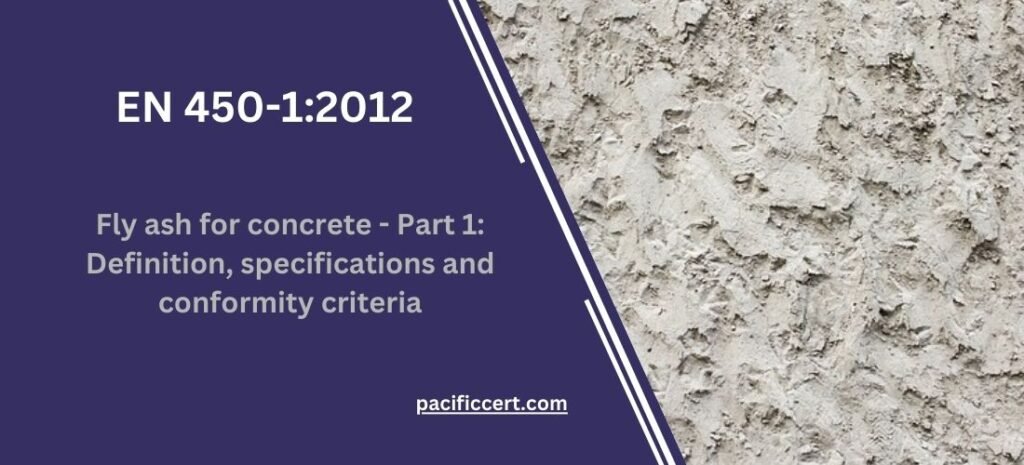
What is EN 450-1:2012- Fly ash for concrete – Part 1: Definition, specifications and conformity criteria?
EN 450-1:2012 provides definition, specifications, and conformity criteria for fly ash used in concrete. Fly ash is a byproduct of coal combustion that can be used as a supplementary cementitious material in concrete production. The standard specifies the properties and requirements that fly ash must meet to be suitable for use in concrete.
The standard covers the following aspects:
Definitions and general requirements: This section provides a definition of fly ash and specifies the general requirements for its use in concrete.
Physical properties: This section specifies the physical properties of fly ash, including its fineness, density, and moisture content.
Chemical properties: This section specifies the chemical properties of fly ash, including its composition, sulphate content, and loss on ignition.
Performance requirements: This section specifies the performance requirements that fly ash must meet. Including its effect on concrete strength, setting time, and durability.
Conformity criteria: This section specifies the conformity criteria for fly ash, including the requirements for sampling, testing, and certification.
EN 450-1:2012 aims to ensure that the use of fly ash in concrete production is safe, effective, and consistent across different suppliers and manufacturers. It provides guidance for producers, users, and regulators to ensure that fly ash meets the necessary requirements for its intended use in concrete.
Requirements of EN 450-1:2012
Definitions: The standard provides definitions for key terms related to fly ash, concrete, and their properties. These definitions help ensure a common understanding of terminology in the context of fly ash for concrete.
Specifications: The standard specifies the physical, chemical, and performance characteristics of fly ash that are suitable for use in concrete production. This may include requirements for particle size distribution, chemical composition, loss on ignition, fineness, and specific gravity, among others.
Conformity Criteria: EN 450-1:2012 establishes conformity criteria that fly ash must meet to be considered suitable for use in concrete. These criteria may define the acceptable limits or ranges for various properties and characteristics of fly ash, ensuring its compatibility with concrete production and performance.
Testing and Evaluation: The standard outlines the testing and evaluation methods to assess the properties and conformity of fly ash. This may include sampling procedures, laboratory testing protocols, and acceptance criteria. To determine whether the fly ash meets the specified requirements.
Quality Control: EN 450-1:2012 also addresses quality control aspects related to fly ash for concrete. This can include requirements for documentation, traceability, and the establishment of quality management systems. To ensure consistent and reliable production and supply of fly ash.
Benefits of EN 450-1:2012
Improved concrete performance: Fly ash is commonly used as a supplementary cementitious material in concrete, contributing to improved workability, durability, and long-term performance of the concrete. So, Compliance with the standard ensures that the fly ash used meets the required quality specifications, leading to enhanced concrete properties.
Sustainable construction: Fly ash is a byproduct of coal combustion, and its utilization in concrete reduces the need for virgin materials, such as cement, thereby reducing the environmental impact of construction activities. Compliance with standards ensures that fly ash is effectively and responsibly in use, contributing to sustainable construction practices.
Consistency and reliability: By adhering to the specifications and conformity criteria outlined in the standard, manufacturers can ensure consistent quality and performance of the fly ash used in concrete production. Thus, this results in more predictable concrete behavior. Allowing contractors and engineers to rely on consistent material properties during construction.
Regulatory compliance: Compliance with EN 450-1:2012 or other relevant standards ensures adherence to regulatory requirements for the use of fly ash in concrete. It facilitates compliance with national or regional regulations and helps demonstrate conformity with quality and performance criteria set by regulatory bodies.
Enhanced market acceptance: Many construction projects, particularly those with sustainability goals, prioritize the use of materials that meet recognized standards. So, By complying with EN 450-1:2012, manufacturers of fly ash can enhance market acceptance of their product, making it more attractive to contractors, specifiers, and project owners who value compliance and quality assurance.
Pacific Certifications is accredited by ABIS, if you need more support with EN 450, please contact us at +91-8595603096 or support@pacificcert.com
Read About: EN 438-7:2005









